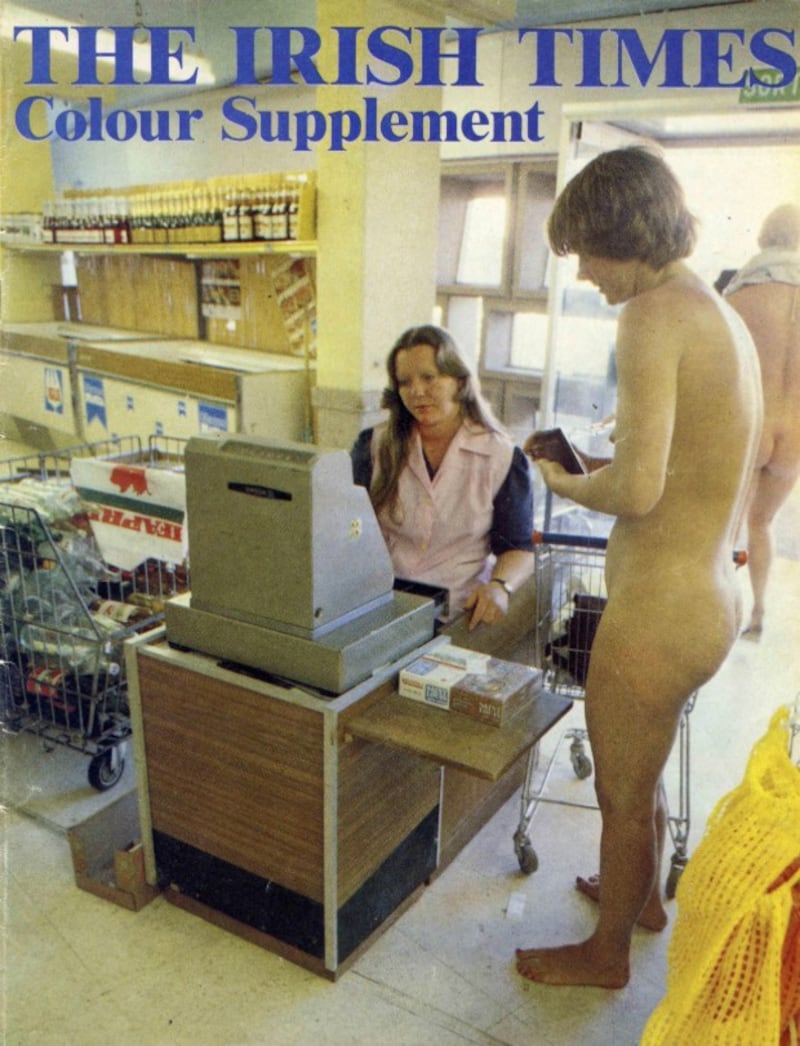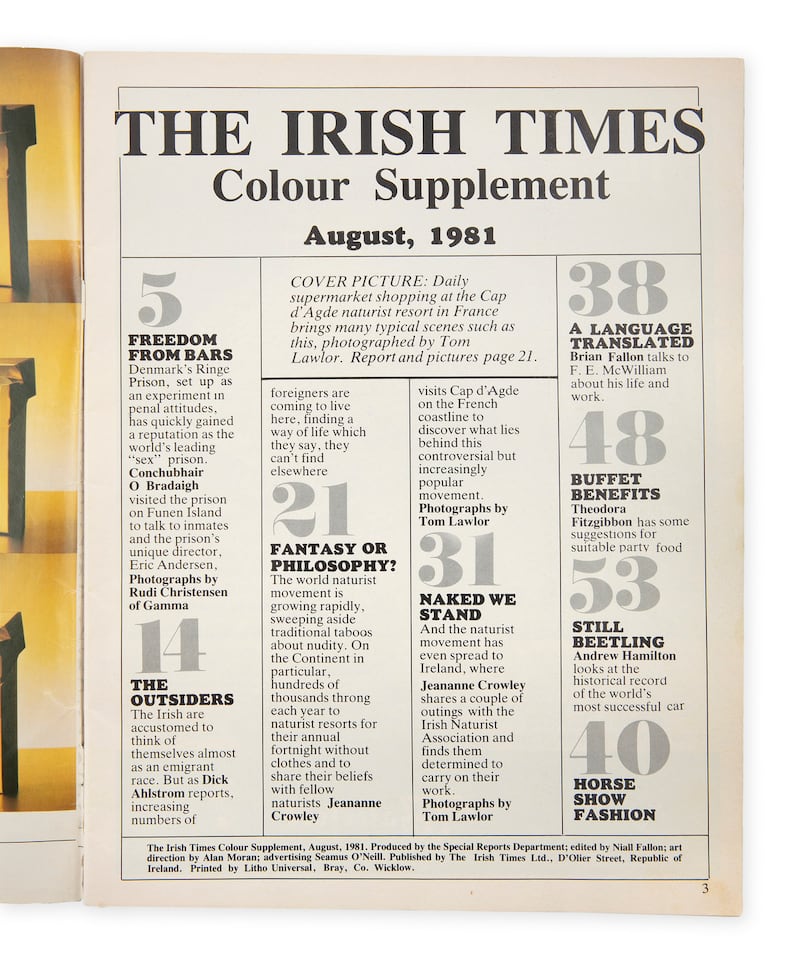The year is 1981. The month is August. On the cover of what is meant to be the precursor to The Irish Times’ now-familiar Saturday colour supplement are two bare bottoms. They belong to two people shopping in a supermarket in Cap d’Agde, a naturist resort in France, which was then the largest such resort in Europe. The name of the magazine is The Irish Times Colour Supplement. The cover story, about the “naturist movement”, which features said unclothed posteriors, was by journalist Jeananne Crowley, with photographs by Tom Lawlor.
That magazine, of which about 82,000 copies were printed to be included with the newspaper one Saturday in August 1981, was never distributed. The entire run was ordered pulped once it was seen by Maj Thomas Blakeney McDowell, the then chairman of the Irish Times Trust. As the paper did not have the facility to design or print colour at the time, the magazine had been printed off-site, by Litho Universal in Bray, Co Wicklow. It was not seen by anyone until it arrived back to D’Olier Street, where the paper was then located, as was its printing press.
“The Major went ballistic when he saw it,” recalls Seamus O’Neill, who was then advertising manager. “He took one look at the nudes on the cover, and he said the magazine had to be shredded. As far as I know, they were all put in skips in Bray and were supposed to be destroyed.”

However, at least one copy survived, and has now emerged for sale. At the end of this month, Adam’s auctioneers is putting the 56-page magazine for sale as a single lot. The estimate is between €3,000 and €5,000. “It’s difficult to price items like this,” explains Niamh Corcoran of Adam’s. “It’s a rarity; a single edition.”
As for the provenance of the magazine, it came to Adam’s via Maj McDowell, who, it appears, despite his incandescence at the time, had in fact kept one copy for himself. He is now deceased. The magazine had since been passed on to a friend, who has now brought it to Adam’s and wishes to remain anonymous.
Groundbreaking
I looked at the magazine in Adam’s. It’s a genuine piece of both Irish Times history and Irish journalism. Nearly four decades ago, this newspaper was attempting a groundbreaking transition to introducing readers to a Saturday colour lifestyle supplement, of the kind now routinely included with weekend newspapers.
It was an experiment; a diversion away from the then 32-page black-and-white newspaper, with the intention of serving existing and new readers who wanted to read more in-depth pieces about lifestyle, features, social affairs, fashion and cookery.
“This was our first foray into colour, and into supplements, in the newspaper,” O’Neill says. “We felt the future was to get into colour, and get into supplements as add-ons to the newspaper.”

Unfortunately, due to the content of that cover story and the subsequent shredding of the offending magazine, it was to be many more years before the Irish Times went with another colour weekend magazine; the one which is still published today.
How did it all happen? “The magazine was commissioned by Niall Fallon, with support from advertising. It was my job to make it a commercial success,” O’Neill recalls. (Fallon, who ran the department that looked after special supplements, died in 1996.) An opportunity to advertise in colour with an Irish newspaper was something completely new at the time. “It was all very under the radar.”
The magazine attracted several full-page colour ads. The front inside cover, for instance, is for Benson & Hedges. The back inside cover is for John Player, and the back cover is for Courvoisier. There are plenty of other large ads inside.
“The ads would have paid for the magazine,” says O’Neill, who reckons it cost in the region of £12,000-£15,000 to get it designed and printed. As the magazine was disposed of, and advertising money had to be returned, that was a significant loss to the paper at the time, and one of the reasons it took so long to attempt relaunching a weekend supplement.
Special visits
All the content was commissioned by Fallon. Future editor Conor Brady, whose byline was then Conchubhair Ó Brádaigh, reported from Denmark on the country’s Ringe Prison, which allowed inmates special visits for the purposes of having sex. “Freedom behind bars” was the name of that story.
Dick Ahlstrom reported on the growing numbers of “foreigners” choosing to live in Ireland, described as those who comprised “our resident alien population”. They included “two Bulgarians, two Bolivians, three Afghans, one Latvian, 1,454 Germans and 2,973 Americans”. The article’s headline was “The outsiders”.
A new vista assaults the already aching gaze, clobbering another taboo for six
There was a feature on the Volkswagen Beetle by Andrew Hamilton, and one on party food by Theodora Fitzgibbon, to tie in with Dublin’s Horse Show. On the menu was avocado mousse, Waldorf salad, and something that has not retained popularity, at least in name: “salamagundi of chicken”. What, pray is that? “A plate of chopped meats, anchovies, eggs and vegetables, arranged in rows for contrast,” according to Google. Some class of salad, I suppose.
The anchor feature was Jeananne Crowley’s report from the naturist resort in France, with several images by Tom Lawlor. She had a second one, too; looking at nudism’s Irish angle by attending a couple of meetings of the Irish Naturist Association.
“Fantasy or philosophy?” was the headline on her story from France. “At each turn a new vista assaults the already aching gaze, clobbering another taboo for six,” Crowley wrote. “At this corner it’s a garage mechanic leaning over an engine with all the confidence of one who has learned to avoid the fan belt . . . Next, it’s one grande maman with enormous white breasts, busily basting the breasts of two equally white chickens as they sizzled away on her patio rotisserie . . .”
And so on.












